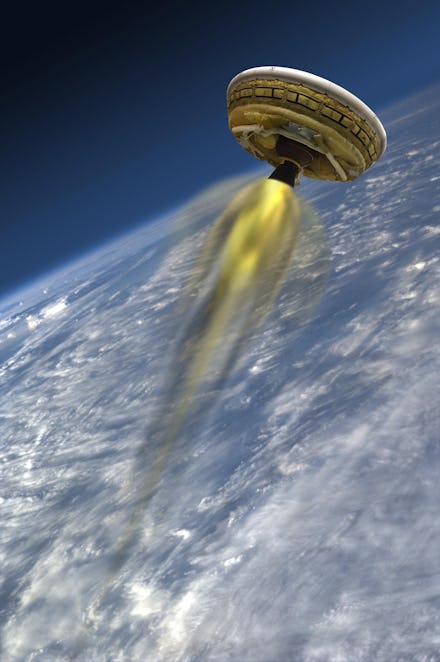NASA's Next Mars Lander Is Actually This Badass Flying Saucer

NASA ran tests Tuesday on its Low-Density Supersonic Decelerator, a literal flying saucer that could eventually put astronauts on Mars.
Since the LDSD spins the same way you see flying saucers spin in movies, it needed to be tested on something called a spin table, like a giant version of what mechanics use to balance wheels — if those wheels were 15.5 feet in diameter. The table's sensors pick up imbalances that would cause the saucer to spin out of whack, possibly breaking loose and cartwheeling off course (or, if it's anything like a car, shake so bad your stereo skips).
It was just one test in a series to make sure the LDSD is the best candidate for launching larger, more involved missions to Mars.
The current challenges: One of the main issues with landing humans on Mars is getting them on the ground safely. Right now, NASA can only send a single metric ton — the exact weight of the Curiosity Mars rover — without it getting completely obliterated on landing.
Since the Red Planet's atmosphere is extremely thin, there isn't much to naturally slow down a spacecraft like Earth's atmosphere does. When the LDSD is traveling at over 1,000 meters per second, that poses a major problem.
Building a saucer-shaped ship creates a wider surface area, which helps keeping it from plummeting to the ground — think bellyflop versus swan dive. The LDSD is also wrapped in a massive Kevlar inner tube-like decelerator to stunt some more of that speed. Finally, a huge parachute will deploy to slow the ship down enough for a surface landing.
Mission to Mars? Being able to slow the LDSD to subsonic speeds will mean the possibility of a lot of added weight. Space.com reports that a craft would need to be 10 to 20 metric tons in order to support manned exploration of Mars.
That means enough capacity to hold a whole crew of astronauts, plus equipment for surface experiments, and enough supplies to run those missions without becoming the first to become the interstellar Donner Party.
There are still more tests to be run, including a June trip out to Hawaii to send the LDSD up in a comparably thin, Mars-like atmosphere — in this case, 120,000 feet above the ground — using a balloon the size of a football field to get it high enough. But if everything goes according to plan, the next ship we send to Mars will look ridiculously similar to the one we thought Mars would send to us.